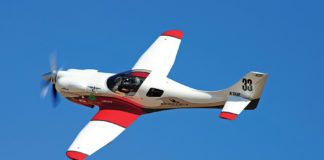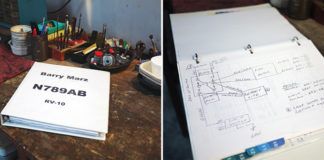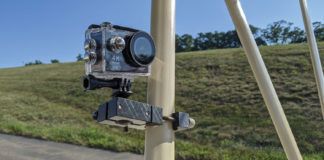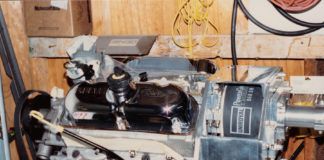In contemplating what the mechanical layout of our lights is going to look like, lets reflect (no pun intended) on the FAA minimum intensities graph from last month. The Feds want the maximum amount of light directly forward and relatively little to the sides. Me? Id like to be lit up like the 4th of July in Philly. I care about getting hit from any direction, front, side or rear, so Ill put out way more than the minimum number of photons fore, aft and side to side. For 15 bucks worth of parts, it is a million dollars worth of peace of mind.
To do this, Im going to put two LEDs in each nav light hole, one facing forward and one facing 90 directly out to the side for the red and green lights. For the white aft light, Im also going to put two of them in the hole, but here I want one facing slightly starboard and the other one facing slightly port. Whats slightly? For best radiation pattern and maximum coverage, Id like the two lights at about a 20 angle between them (10 each side of center).
Talking Temps
Now that we have the mechanical stuff sort of in hand, it is time to discuss temperature. The LEDs themselves consume about 2.5 watts each, or 5 watts for a dualie on each wingtip and the tail-feathers. Somehow we have to get rid of that heat. How hot will things get?
In solid-state work, we have a concept called thermal resistance, which tells us how much heat each of the paths between the diode junction and free air is going to cost in temperature rise. Lets work backwards to see what temperature well need for the heat sink at (wingtip or rudder mounting plate) and to keep the diode within its ratings. The diode junction itself doesn’t want to be anything over 150 Celsius. The junction-to-case thermal resistance is 11 C/watt, so just getting from the junction out into the real world is going to cost us (11 times 2.5 watts) 28 C. That means we are going to have to keep the case of the diode below (150 – 28) 122 C. The thermal resistance between the case and the mounting plate (supplied already attached to the case) is another 2 C/watt, or another loss of 5 C. Now we know what the maximum temperature of the mounting plate must be 122 – 5, or 117 C. Does this seem reasonable? Other than the engine, does anything in the airplane get this hot? Remember, 117 C is about 240 F, or about the top end of the green arc for oil temperature. Hot. Spit-sizzle hot.
What is spit-sizzle hot? Thats when you lick your finger and momentarily touch it to the surface in question. If the spit sizzles, then the surface is above the boiling point of water (100 C or 212 F). If the spit doesn’t sizzle, then the old geezers among us have developed, over the years, a roughly calibrated thermometer called the how long can you leave your finger on this sucker method. It is different for everybody as a function of how calloused your fingers have become, but most of us can tell within 20 or so how hot a surface is by how long we can leave our finger on it before it hurts bad enough to pull it off.
To find out how hot the surface is going to get, I fired up the two red LEDs and ran them at their rated current (more about this later). I monitored them carefully for half an hour to make sure that they werent getting spit-sizzle hot and then measured them with my carefully calibrated finger. I also let them run overnight at rated current to be sure that I wasn’t seeing some other phenomenon dissipating heat that I wasn’t aware of. In both cases, the heat sink (wingtip aluminum flange) got to 39 C (104 F) and stabilized. Thats not even a good summers day in a lot of places. The ambient air is a nice cool springtime 20 C, so that means that at full-bore current the heat sink rise is 19 C over ambient. Because the heat sink can go to 117 C, the ambient can be as high as 98 C (205 F), or just about boiling water hot. Not likely, even in an Arizona summers midday. Heat Conductors
Now, one more word about heat and we can plow into the electronics. Bolting a flat piece of bent aluminum flange-heat sink to a flat piece of LED mounting plate should conduct all the heat of the plate into the heat sink. Should. Wont. I don’t care how flat you think the sink is, or how flat you machine the diode plate, there will be microscopic hills and valleys that make for less than perfect heat conduction. The good news is that most of the usual suspects (Mouser, Digikey and even Rat Shack) carry thermal compound, which is nothing more than a metal oxide in paste form that will fill in the valleys and round out the hills so that all the heat gets from the diode into the heat sink. This so-called goose grease isn’t cheap by a long shot, but the small quarter-ounce tube I bought when I started RST Engineering in 1973 is still about half full. And Ive done a lot of heat-sink work in those 35 years. One emergency replacement you can try if you just cant find any thermal compound is to go to the drugstore and get a small tube of zinc oxide. Thats the white paste some people put on their nose so that it doesn’t sunburn. It isn’t quite as good as real thermal compound, but it will do in a pinch.
The one trick I will impart to you before we leave the goose grease subject is that too much grease is as bad as no grease. The trick is to use a thin layer of the stuff. If you cant see the metal shining through the layer, you’ve used too much. Remember, you are trying to fill little canyons that are millionths of an inch deep, not a quarter-inch deep. And the stuff is messy. Use too much, slop it all around, and you will be wasting hours trying to get it cleaned up. I believe that MEK is the solvent for thermal grease but (a) it is also the solvent for the epoxy diode case, and (b) Im not all that shot up about using MEK to wipe grease off my skin.
The Electronics
On to the electronics of the little rascals. We said last month we were going to use the LEDengin series of 3-watt LEDs (LZ1-10?103, where ? is replaced by R for red, G for green and CW for cool white). Referring to the company’s data sheets, it appears that the lamps are rated for 100,000 hours if we run them at 700 mA (0.7 amps). But if we heat sink them well enough we can run them at 1000 mA (1.0 amp) if desired. As a matter of fact, the temperature test data I reported above resulted from running the diodes in series at 1000 mA overnight, so if you want a little bit less life you can boop (thats a technical term, you’ll get used to it) the current up to an amp. I mean, really, 100,000 hours is a little over 11 years running 24/7, so how much do you really think the life will be shortened by running them at their rated maximum? Nine years? Eight years? Is there anybody around who has amassed that much night time?
The problem is that the diode voltage versus current curve is fairly steep, so if we are going to run constant voltage, it is going to have to be a well regulated voltage. While constant current supplies aren’t all that difficult to design, doing a switching regulated constant current supply is a real trick.
So what are we talking here? My measurements showed the following voltages and currents for the red LEDs (two of them in series). At 700 mA the voltage was 4.09 volts, and at 1000 mA the voltage was 4.27 volts. This is a difference of 0.18 volts (180 millivolts) from low current to high current. Thats a little over 4%, and a well designed switching power supply can easily hold better than a tenth of that (0.4%) over variations of battery voltage and temperature. To go one step further (and spend another half a buck of your money) well use a ballast resistor to open up the voltage spread between low and high current. We have headroom of about 8 volts between the 12-volt aircraft bus and the 4 volts of the LEDs, so why not use some of that to make the adjustment of the diode current a little easier?
Next month we will look at the switching regulator and the final details of the nav light design, plus a little trick to get your fellow aviators attention at night. Stay tuned.













